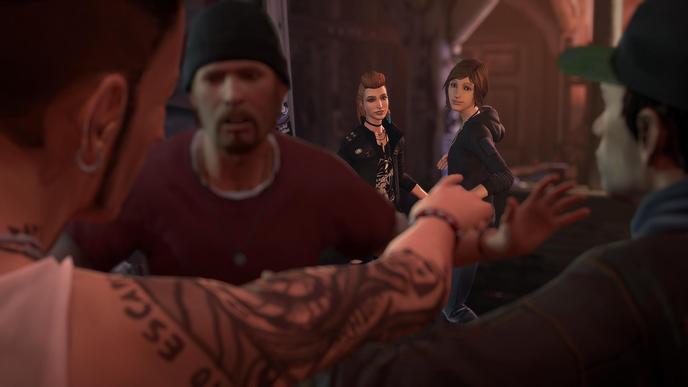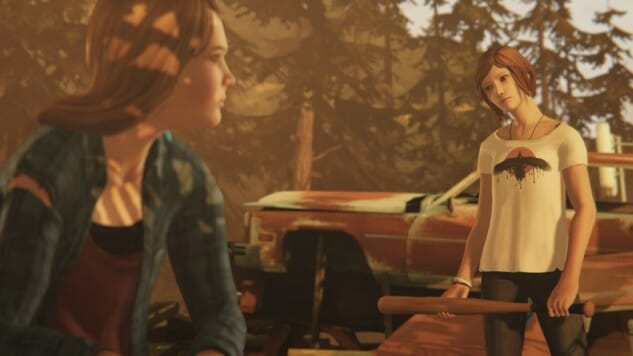The first Life is Strange is great. An adventure game about teen girl Max and her time-traveling super powers set in the Pacific Northwest, it’s an excellent mix of mystery, light puzzle-solving and character development that somehow all manages to fit together into an enjoyable whole. The dialogue’s clunky, and the characters sometimes make weird decisions, but there are a lot of places where a player can get hooked. Maybe the biggest place where the most people are hooked is in the relationship between Max and Chloe, her scrappy childhood friend whose attitude and emotional rawness are the perfect counterpoints to Max’s muted personality.
Life Is Strange: Before the Storm takes place a few years before Life Is Strange proper. There is no Max, and there are no time-traveling powers. Instead, there is a teen Chloe, a girl who is simply trying to figure out her place in the world amidst school troubles, her mom’s crappy boyfriend and mosh pits. Like the original, it’s an adventure game where the player explores areas like Chloe’s house or a park in order to solve small puzzles that help move the story forward. At the baseline, it is successful at all of these things: it tells a prequel story, it is an adventure game, and we get to know more about Chloe.
However, Before the Storm fails to match up to its predecessor beyond those basic structural pieces, and the reasons that it fails to match up are instructive and interesting. In no way do I think that Before the Storm is a bad game. Instead, I think it’s a game that makes specific formal choices that, at the end of the day, just cannot provide the same kind of support that the robust mechanics of the original game could have.
In Life Is Strange, Max’s time control powers mean that each area has puzzles that exist in both time and space. Players navigate an area, figure out how the people and objects in it interact over time, and then intervene at critical moments in order to “solve” a given puzzle. Before the Storm drops the time element from the game, meaning that players don’t need to do that kind of investigative work that they do in the previous game. Rather, every area of the game is an exercise in “walk around the zone and interact with every single object.” This is about as exciting as an I Spy book. Those are fine if you enjoy them, but that’s not necessarily why I am playing brand-new adventure games.
The only mechanic that has appeared to replace the loss of time travel superpowers is Chloe’s use of the Backtalk Challenge. These are aggressive conversations where Chloe ridicules, yells at and otherwise dominates the person she’s talking to. To do these optimally, you simply pay attention to what the other person is saying and respond with the dialogue option that most clearly responds to them with their own words. It is a game mechanic that is uncomfortably Venn Diagrammed with “I know you are, but what am I,” and it just feels weak as a way of interacting with the world.

With that mechanical move away from interacting with objects and toward more robust dialogue mechanics, Before the Storm doubles down on the power of conversation. When the game is really focusing in on that, especially away from Backtalk Challenges, it shines. For example, there is a scene where Chloe can optionally play a Dungeons & Dragons-esque tabletop game with some friends, and it is flawless: it is well-written, the visual direction is impressive and clever, and it allows you to be both inside Chloe’s head and outside her to see the difference between her self image and the image that others have of her. It is a scene that does work, and as best I can tell it is entirely skippable and wholly singular in the first episode.
Even that scene, as great as it is, runs into another issue that really drags Before the Storm down. In a bid for authenticity or real-world grounding, the game makes the choice to pepper itself with references. Blade Runner’s director’s cut gets name checked, someone utters the phrase “perfect dark,” The Tempest seems to be playing a serious part in the narrative structure going forward, and Twin Peaks gets a lot of play through symbols and names. The band that Chloe sees in the opening is called Firewalk, for God’s sake.
Life Is Strange was more than a little reliant on the narrative conceit of the original Twin Peaks series. A young woman, Rachel Amber, was missing and presumed dead, and solving that mystery was part of what drove that game. By following Rachel through the winding world of the old money rich, RV-driving drug dealers, and a high school social club, we were able to learn about the town of Arcadia Falls and Rachel’s different relationships to the people there. This is exactly how Laura Palmer’s death functioned in the Twin Peaks series, and much like Fire Walk With Me, the prequel film to that show that elaborated on Laura’s life before her death, Before the Storm is showing us Rachel Amber before her disappearance.
In this first episode, that show-and-tell about Rachel just doesn’t work. The developers of Before the Storm take for granted that we know that Chloe and Rachel will immediately have a strong bond, and the whirlwind meetings over the couple days of this episode feel less like a relationship that builds and more like a manic pixie dream girl setup from a film from the early 2000s. It is clear that we need to rush to the “payoff” of Chloe and Rachel Amber having a connection, but the means through which we get there don’t seem earned to me. That’s a problem in a game where the story beats are the only thing there to keep me invested; I’m supposed to want to see what happens next, and if that is a predictable and preordained order of things that is retroactively handed down backward from the original game, then the journey needs to feel like it was worth making.
I spent a lot of time being unhappy with this first episode of Before the Storm. I also felt the same way about the first episode of the first game, though, and I generally feel the same way about every episodic game I play. It might be the case that two hours of videogame narrative just isn’t enough to get me invested in the world and characters; I might need some time for this particular iteration to sink in. Ultimately, I want to enjoy Before the Storm as much as I did Life is Strange, but I think some serious shifts will have to take place between this episode and the next in order for me to really get onboard.
Life is Strange: Before the Storm was developed by Deck Nine and published by Square Enix. Our review is based on the PlayStation 4 version. It is also available for Xbox One and PC.
Cameron Kunzelman tweets at @ckunzelman and writes about games at thiscageisworms.com. His latest game, Epanalepsis, was released last year. It’s available on Steam.

